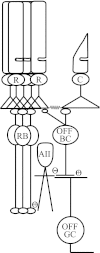Dark-adapted response threshold of OFF ganglion cells is not set by OFF bipolar cells in the mouse retina
- PMID: 22338022
- PMCID: PMC3362285
- DOI: 10.1152/jn.01202.2011
Dark-adapted response threshold of OFF ganglion cells is not set by OFF bipolar cells in the mouse retina
Abstract
The nervous system frequently integrates parallel streams of information to encode a broad range of stimulus strengths. In mammalian retina it is generally believed that signals generated by rod and cone photoreceptors converge onto cone bipolar cells prior to reaching the retinal output, the ganglion cells. Near absolute visual threshold a specialized mammalian retinal circuit, the rod bipolar pathway, pools signals from many rods and converges on depolarizing (AII) amacrine cells. However, whether subsequent signal flow to OFF ganglion cells requires OFF cone bipolar cells near visual threshold remains unclear. Glycinergic synapses between AII amacrine cells and OFF cone bipolar cells are believed to relay subsequently rod-driven signals to OFF ganglion cells. However, AII amacrine cells also make glycinergic synapses directly with OFF ganglion cells. To determine the route for signal flow near visual threshold, we measured the effect of the glycine receptor antagonist strychnine on response threshold in fully dark-adapted retinal cells. As shown previously, we found that response threshold for OFF ganglion cells was elevated by strychnine. Surprisingly, strychnine did not elevate response threshold in any subclass of OFF cone bipolar cell. Instead, in every OFF cone bipolar subclass strychnine suppressed tonic glycinergic inhibition without altering response threshold. Consistent with this lack of influence of strychnine, we found that the dominant input to OFF cone bipolar cells in darkness was excitatory and the response threshold of the excitatory input varied by subclass. Thus, in the dark-adapted mouse retina, the high absolute sensitivity of OFF ganglion cells cannot be explained by signal transmission through OFF cone bipolar cells.
Figures









Similar articles
-
Light signaling in scotopic conditions in the rabbit, mouse and rat retina: a physiological and anatomical study.J Neurophysiol. 2005 Jun;93(6):3479-88. doi: 10.1152/jn.00839.2004. Epub 2004 Dec 15. J Neurophysiol. 2005. PMID: 15601738
-
Cross-talk between ON and OFF channels in the salamander retina: indirect bipolar cell inputs to ON-OFF ganglion cells.Vision Res. 2007 Feb;47(3):384-92. doi: 10.1016/j.visres.2006.09.021. Epub 2006 Nov 7. Vision Res. 2007. PMID: 17092534
-
Light adaptation alters the source of inhibition to the mouse retinal OFF pathway.J Neurophysiol. 2013 Nov;110(9):2113-28. doi: 10.1152/jn.00384.2013. Epub 2013 Aug 7. J Neurophysiol. 2013. PMID: 23926034 Free PMC article.
-
[The post-synaptic glycine receptor mediates in a transitory and sustained way the glycinergic inhibition in the vertebrate retina].Rev Neurol. 2012 Jul 1;55(1):38-46. Rev Neurol. 2012. PMID: 22718408 Review. Spanish.
-
Intrinsic properties and functional circuitry of the AII amacrine cell.Vis Neurosci. 2012 Jan;29(1):51-60. doi: 10.1017/S0952523811000368. Vis Neurosci. 2012. PMID: 22310372 Free PMC article. Review.
Cited by
-
Vision: Life on the dark side.Curr Biol. 2022 Jul 11;32(13):R741-R743. doi: 10.1016/j.cub.2022.06.001. Curr Biol. 2022. PMID: 35820384 Free PMC article.
-
Cone synapses in mammalian retinal rod bipolar cells.J Comp Neurol. 2018 Aug 15;526(12):1896-1909. doi: 10.1002/cne.24456. Epub 2018 May 6. J Comp Neurol. 2018. PMID: 29667170 Free PMC article.
-
The AII amacrine cell connectome: a dense network hub.Front Neural Circuits. 2014 Sep 4;8:104. doi: 10.3389/fncir.2014.00104. eCollection 2014. Front Neural Circuits. 2014. PMID: 25237297 Free PMC article.
-
Transience of the Retinal Output Is Determined by a Great Variety of Circuit Elements.Cells. 2022 Feb 25;11(5):810. doi: 10.3390/cells11050810. Cells. 2022. PMID: 35269432 Free PMC article. Review.
-
Dendro-somatic synaptic inputs to ganglion cells contradict receptive field and connectivity conventions in the mammalian retina.Curr Biol. 2022 Jan 24;32(2):315-328.e4. doi: 10.1016/j.cub.2021.11.005. Epub 2021 Nov 24. Curr Biol. 2022. PMID: 34822767 Free PMC article.
References
-
- Bloomfield SA, Dacheux RF. Rod vision: pathways and processing in the mammalian retina. Prog Retin Eye Res 20: 351–384, 2001 - PubMed
-
- Chang B, Dacey MS, Hawes NL, Hitchcock PF, Milam AH, Atmaca-Sonmez P, Nusinowitz S, Heckenlively JR. Cone photoreceptor function loss-3, a novel mouse model of achromatopsia due to a mutation in Gnat2. Invest Ophthalmol Vis Sci 47: 5017–5021, 2006 - PubMed
Publication types
MeSH terms
Substances
Grants and funding
LinkOut - more resources
Full Text Sources
Research Materials

